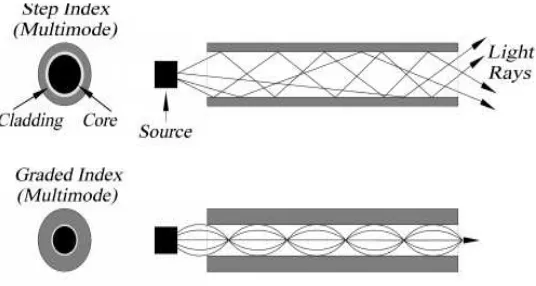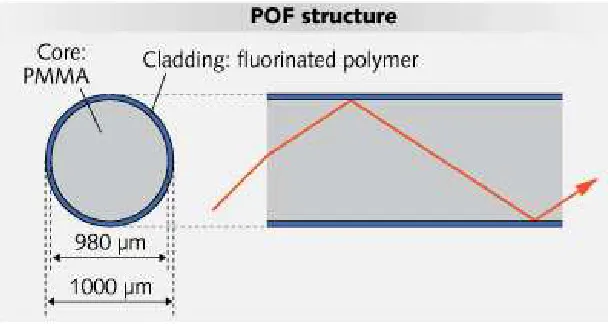UNIVERSITI TEKNIKAL MALAYSIA MELAKA
FIBER OPTIC SENSOR FOR CORN OIL CONCENTRATION
DETECTION AND OPTIMIZATION PERFORMANCE USING
ANALYSIS TECHNIQUE
This report submitted in accordance with requirement of Universiti Teknikal Malaysia Melaka (UTeM) for the Bachelor‟s Degrees in Electronic Engineering
Technology (Telecommunications) with Honours
by
NOORADILA BINTI ZAINE B071210240
900129-02-5422
UNIVERSITI TEKNIKAL MALAYSIA MELAKA
BORANG PENGESAHAN STATUS LAPORAN PROJEK SARJANA MUDA
TAJUK: Fiber Optic Sensor for Corn Oil Concentration Detection and Optimization Performance Using Analysis Technique
SESI PENGAJIAN: 2015/2016 Semester 1
Saya NOORADILA BINTI ZAINE
mengaku membenarkan Laporan PSM ini disimpan di Perpustakaan Universiti Teknikal Malaysia Melaka (UTeM) dengan syarat-syarat kegunaan seperti berikut:
1. Laporan PSM adalah hak milik Universiti Teknikal Malaysia Melaka dan penulis. 2. Perpustakaan Universiti Teknikal Malaysia Melaka dibenarkan membuat salinan untuk
tujuan pengajian sahaja dengan izin penulis.
3. Perpustakaan dibenarkan membuat salinan laporan PSM ini sebagai bahan pertukaran antara institusi pengajian tinggi.
4. **Sila tandakan ( )
SULIT
TERHAD
TIDAK TERHAD
(Mengandungi maklumat yang berdarjah keselamatan atau kepentingan Malaysia sebagaimana yang termaktub dalam AKTA RAHSIA RASMI 1972)
(Mengandungi maklumat TERHAD yang telah ditentukan oleh organisasi/badan di mana penyelidikan dijalankan)
iii
DECLARATION
“I hereby, declare this report entitled “Fiber Optic Sensor for Corn Oil Concentration Detection and Optimization Performance Using Analysis Technique” is the result of my
own research except as cited in references”
Signature : ………...
Author‟s Name : NOORADILA BINTI ZAINE
Date :………
iv
APPROVAL
This report is submitted to the Faculty of Engineering Technology of UTeM as a partial fulfillment of the requirements for the degree of Bachelor of Engineering Technology (Telecommunication) with Honours. The member of the supervisory is as follow:
………..
v
ABSTRACT
vi
ABSTRAK
vii
… Dedicated to...
My beloved Father and Mother
Zaine Bin Bakar and Jameah Binti Hashim
My sisters and Family
Thank You from the Bottom of My Heart for Being My Inspirations
And Lastly to All My Dear Friends
viii
ACKNOWLEDGEMENT
I wish to express my sincere appreciation to my supervisors, Mr. Md Ashadi bin Md Johari for his amazing knowledge, talent and belief in this thesis. Thanks you for offering enormous and professional advice, guidance and motivation towards the success of the thesis. Without his continuous support and interest, this thesis would not have been the same as presented here.
My sincere appreciation also extends to my co supervisor, Mrs. Rahaini binti Mohd Zain. I am grateful for their assistance and guide me how to do the analysis technique for the purpose of my study.
I am also indebted to all my colleagues and other who have provided assistance at various occasions. Their view and tips were useful indeed.
Finally, I wish to express my gratitude to my family members for their continuous to my family members for their continuous support and motivation.
x
2.4 Types of Fiber Optic………...7
2.4.1 Multimode Fiber………7
2.4.2 Single Mode Fiber………...9
2.4.3 Plastic Optical Fiber (POF)………...9
2.5 Advantages and Disadvantages of Fiber Optic ………...11
2.5.1 Advantages of Fiber Optic………..11
2.5.2 Disadvantages of Fiber Optic………..12
2.6 How Fiber Optic Cable Work………...13
2.6.1 Total Internal Reflection………....13
2.7 Fiber Optic Sensor……….14
2.7.1 Study of Intensity Modulated Fiber Optic Sensor……….14
2.8 Corn Oil………..23
2.8.1 Performance, Combustion and Emission Characteristic of Corn Oil with Diesel………..23
2.9 Light Source………...29
2.9.1 Light Emitting Diode (LED)………..29
xi
CHAPTER 4……….37
4.1 Introduction ………..37
4.2 Block Diagram of Project………...37
4.3 Experiment Result………..39
4.4 Discussion Result………...41
CHAPTER 5……….45
5.1 Introduction……….45
5.2 Discussion and Conclusion for the Chapter 3……….45
5.3 Discussion and Conclusion for the Chapter 4……….46
5.4 Future Work……….47
APPENDIX………...48
xii
LIST OF FIGURES
Figure 2.1 : Fiber Optic………6
Figure 2.2 : Fiber Optic Cable Construction………6
Figure 2.3 : Multimode Step Index and Multimode Graded Index……….8
Figure 2.4 : Single Mode Fiber………9
Figure 2.5 : Typical Structure for POF………..10
Figure 2.6 : Total Internal Reflection………....13
Figure 3.1 : Step of Project Methodology………..33
Figure 3.2 : Flow Chart of Project Thesis……….….36
Figure 4.1 : Block Diagram of Fiber Optic Sensor………38
Figure 4.2 : Voltage versus Liquid Concentration……….40
Figure 4.3a : 1st Slope of Light Source length 1310nm………...42
Figure 4.3b : 2nd Slope of Light Source length 1310nm……….….42
Figure 4.3c : 1st Slope of Light Source length 1550nm………..43
xiii
LIST OF TABLE
Table 2.1 : The Comparison of LED and Laser Diode………..30
Table 4.1 : Voltage Fiber Optic Sensor Value for Concentration of
Corn Oil……….….……39
xiv
LIST OF SYMBOLS AND ABBREVIATIONS
POF Plastic Optical Fibre
NA Numerical Aperture
SPR Surface Plasmon Resonance
TM Transverse Magnetic
FST Fluorescence Signal Transmission
EST Electrochemical Signal Transduction
TIR Total Internal Reflection
PPM Parts Per Million
ASE Amplified Spontaneous Emission
1
CHAPTER 1
INTRODUCTION
1.1 Project Background
Nowadays, speed of data transmission is being given a prior for human being to perform well in their specific field of task. Speed of data transmitted is being concerned especially for engines and communication, where it helps human being to perform well in their life. Fiber has become communications medium of choice for telephones, cell phones, LAN backbone, security cameras, industrial networks, just about every kind of communication. The biggest advantage of optical fiber is the fact it is the most cost effective means of transporting information. Fiber can transport more information longer distances in less time than any other communication medium. The bandwidth and distance capability of fiber means that fewer cables, fewer repeaters, less power and less maintenance are needed. In addition, fiber is unaffected by the interference of electromagnetic radiation which makes it possible to transmit information and data with less noise and less error.
2
Next, corn oil is oil extracted from the germ of corn. Its main use is in cooking, where its high smoke point makes refined corn oil valuable frying oil. Corn oil is also a feedstock used for biodiesel. Other industrial uses for corn oil include soap, salve, paint, rust proofing for metal surfaces, inks, textiles and insecticides. It is sometimes used as a carrier for drug molecules in pharmaceutical preparations.
However, this project is to analyze sensitivity of fiber optic sensor in determine the concentration of corn oil. This corn oil will used by replacing petroleum. Other than that, fiber are used to detect concentration because believe only right concentration can be used as a fuel. But, difference of dilution would affect the result and the fiber optic sensors have proven can be a good sensor. So, this project is to develop a fiber optic sensor for detecting the difference dilution of corn oil. Faster transmission and higher sensitivity of the sensor helps in increase the efficiency of the analysis of corn oil‟s concentration. This analysis may being a useful technology to be used in oil and gas sector.
In addition, this project also use analysis technique which a process of inspecting, cleaning, transforming, and modeling data with the goal of discovering useful information, suggestion conclusion, supporting decision making. This technique is a method to determine the relationship between factors affecting a process and the output of that process. In other words, it is used to find cause-and-effect relationships. This information is needed to manage process inputs in order to optimize the output.
1.2 Problem Statement
3
broken down by other material such as Hexene. Hexene is an organic compound with the formula C6H12. It is an alkene that is classified in industry as higher olefin and alpha-olefin, the latter term meaning that the double bond is located at the alpha (primary) position, endowing the compound with the higher reactivity and thus useful chemical properties. This Hexene are needed to turn on the engine. In addition, Hexene are used to make the corn oil was suitable for the engine. Hexene can‟t be included directly because it has the concentrations. So, this corn oil and Hexene influence the result for optical fibers. For example, how many percent corn oil and Hexene was needed and it will affect the result for optical fibers.
1.3 Project Objectives
There are three main objectives in this study which lead to project success. The objective of the project is to;
1. To understand fiber optic communication. 2. To develop fiber optic sensor.
3. To analyze the performance of fiber optic sensor in identifying the concentration of corn oil.
1.4 Project Scope
4 The scope of study includes:
1. Understanding of fiber optic sensor and properties. 2. Design fiber optic to be used as a sensor.
5
CHAPTER 2
THEORETICAL BACKGROUND
2.1 Introduction
This section present about theoretical background. Before design the fiber optic sensor for corn oil, concentration detection and optimization, need to understand the concept of fiber optic and how it works. The concept of fiber optic is described in more detail. Addition, the previous research based on fiber optic sensor, corn oil and light sources included on this chapter.
2.2 Fiber Optics
6
or wireless method. It‟s powerful and very fast-offering more bandwidth capability than any other form of communication. [Hayes J., 2009]
Figure 2.1: Fiber Optic Cable
2.3 Fiber Optic Cable Construction
Figure 2.2: Fiber Optic Cable Construction
7
glass or plastic that‟s measured in micron (μ) by the size of its outer diameter. The larger the core, the more light the cable can carry. For cladding it is thin layer that surrounds the fiber core and serves as a boundary that contains the light waves and causes the refraction, enabling data to travel throughout the length of the fiber segment. Next, coating is a layer of plastic that surrounds the core and cladding to reinforce and protect the fiber core. The strengthening fibers help protect the core against crushing forces. Last but not least, the cable jacket is the outer layer of any cable. Most fiber optical cables have an orange jacket, although some types can have black or yellow jackets.
2.4 Types of Fiber Optic
There are two basic types of fiber: multimode fiber and single-mode fiber. Multimode fiber is best designed for short transmission distances, and is suited for use in LAN systems and video surveillance. Single-mode fiber is best designed for longer transmission distances, making it suitable for long-distance telephony and multichannel television broadcast systems.
2.4.1 Multimode Fiber
8
For the step-index multimode fiber was the first design. The core of step index multimode fiber is made completely of one types of optical material and the cladding is another type with different optical characteristic. It has higher attenuation and is too slow for many uses, due to the dispersion caused by the different path lengths of the various modes travelling in the core. Step index fiber is not widely used- only POF and PCS/HCS (plastic or hard clad silica, plastic cladding on a glass core) use a step index design today. POF mainly used for consumer audio and TV links.
Next for the Graded index multimode fiber uses variations in the composition of the glass in the core to compensate for the different path lengths of the modes. It offers hundreds of times more bandwidth than step index fiber-up to about 2 gigahertz. Two types are in use, 50/125 and 62.5/125, where the numbers represent the core/cladding diameter in microns. Graded index multimode fiber is primarily used for premises networks, LANs, fiber to the desk, CCTV and other security systems. [Hayes J., 2009]
9 2.4.2 Single Mode Fiber
Single mode fiber has a much smaller core, only about 9 microns, so that the light travels in only one ray (mode). It is used for telephony and CATV with laser sources at 1300 and 1550 nm because it has lower loss and virtually infinite bandwidth. Single mode fiber is use for outside plant networks such as telco, CATV, municipal networks and long data links such as utility grid management. [Hayes J., 2009]
Figure 2.4: Single Mode Fiber
2.4.3 Plastic Optical Fiber (POF)
10



